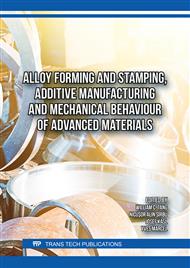[1]
R. Neu, R. Dux, A. Kallenbach, T. Pütterich, M. Balden, J.C. Fuchs, A. Herrmann, C.F. Maggi, M. O'Mullane, R. Pugno, I. Radivojevic, V. Rohde, A.C.C. Sips, W. Suttrop, A. Whiteford, the A.U. team, Tungsten: an option for divertor and main chamber plasma facing components in future fusion devices, Nuclear Fusion 45 (2005) 209.
DOI: 10.1088/0029-5515/45/3/007
Google Scholar
[2]
Q. Xu, N. Yoshida, T. Yoshiie, Accumulation of helium in tungsten irradiated by helium and neutrons, Journal of Nuclear Materials 367–370 (2007) 806–811.
DOI: 10.1016/j.jnucmat.2007.03.078
Google Scholar
[3]
W. Qin, C. A. K., J.A. and Szpunar, Helium bubble nucleation at grain boundaries and its influence on intergranular fracture, Philosophical Magazine 99 (2019) 679–698.
DOI: 10.1080/14786435.2018.1551634
Google Scholar
[4]
H. Zhao, X. Zeng, X. Yang, W. Chen, J. Wu, Investigation of the temperature effect on the primary radiation damage near the grain boundary in tungsten using Molecular dynamics simulations, Nucl Instrum Methods Phys Res B 476 (2020) 32–39.
DOI: 10.1016/j.nimb.2020.04.030
Google Scholar
[5]
J. Cui, Q. Hou, M. Li, B. Fu, Molecular dynamics simulations of interaction of cascade damage with self-interstitial atom-loaded grain boundaries in tungsten, Solid State Commun 389 (2024) 115575.
DOI: 10.1016/j.ssc.2024.115575
Google Scholar
[6]
C.G. Zhang, W.H. Zhou, Y.G. Li, Z. Zeng, X. Ju, Primary radiation damage near grain boundary in bcc tungsten by molecular dynamics simulations, Journal of Nuclear Materials 458 (2015) 138–145.
DOI: 10.1016/j.jnucmat.2014.11.135
Google Scholar
[7]
J. Jian, L. Shi, B. Zhang, The behavior of helium bubble evolution under neutron irradiation in different tungsten surfaces, Journal of Nuclear Materials 593 (2024) 154994.
DOI: 10.1016/j.jnucmat.2024.154994
Google Scholar
[8]
J. Cui, M. Li, B. Fu, Q. Hou, Atomistic study on the dynamic response of helium bubbles to high-energy displacement cascades in tungsten, Nucl Instrum Methods Phys Res B 510 (2022) 29–38.
DOI: 10.1016/j.nimb.2021.10.015
Google Scholar
[9]
J. Cui, Q. Hou, M. Li, M. Qiu, Molecular dynamics simulations of cascade overlap with Void/Helium bubble, Nuclear Materials and Energy 32 (2022) 101232.
DOI: 10.1016/j.nme.2022.101232
Google Scholar
[10]
C. González, R. Iglesias, Cluster formation and eventual mobility of helium in a tungsten grain boundary, Journal of Nuclear Materials 514 (2019) 171–180.
DOI: 10.1016/j.jnucmat.2018.11.029
Google Scholar
[11]
Y. Jiang, Z. Sun, D. Wang, D. Sun, X. Qi, D. Yun, W. Liu, Effects of grain boundaries on the evolution of radiation-induced bubbles in polycrystalline tungsten: A phase-field simulation, Journal of Nuclear Materials 588 (2024) 154757.
DOI: 10.1016/j.jnucmat.2023.154757
Google Scholar
[12]
Z. Chen, L.L. Niu, Z. Wang, L. Tian, L. Kecskes, K. Zhu, Q. Wei, A comparative study on the in situ helium irradiation behavior of tungsten: Coarse grain vs. nanocrystalline grain, Acta Mater 147 (2018) 100–112.
DOI: 10.1016/j.actamat.2018.01.015
Google Scholar
[13]
S. Plimpton, Fast Parallel Algorithms for Short-Range Molecular Dynamics, J Comput Phys 117 (1995) 1–19.
Google Scholar
[14]
A. Stukowski, Visualization and analysis of atomistic simulation data with OVITO–the Open Visualization Tool, Model Simul Mat Sci Eng 18 (2010) 015012.
DOI: 10.1088/0965-0393/18/1/015012
Google Scholar
[15]
J. Cui, M. Li, J. Wang, Q. Hou, Molecular dynamics study of helium bubble pressure in tungsten, Nucl Instrum Methods Phys Res B 352 (2015) 104–106.
Google Scholar
[16]
M. Abu-Shams, J. Moran, I. Shabib, Displacement cascade evolution in tungsten with pre-existing helium and hydrogen clusters: a molecular dynamics study, 111 (2020) 698–705.
DOI: 10.3139/146.111927
Google Scholar
[17]
Y. Chen, J. Fang, X. Liao, N. Gao, W. Hu, H.B. Zhou, H. Deng, Energetics and diffusional properties of helium in W-Ta systems studied by a new ternary potential, Journal of Nuclear Materials 549 (2021) 152913.
DOI: 10.1016/j.jnucmat.2021.152913
Google Scholar
[18]
J.F. Ziegler, J.P. Biersack, The Stopping and Range of Ions in Matter, in: D.A. Bromley (Ed.), Treatise on Heavy-Ion Science: Volume 6: Astrophysics, Chemistry, and Condensed Matter, Springer US, Boston, MA, 1985: p.93–129.
DOI: 10.1007/978-1-4615-8103-1_3
Google Scholar
[19]
A.M. Ito, Y. Yoshimoto, S. Saito, A. Takayama, H. Nakamura, Molecular dynamics simulation of a helium bubble bursting on tungsten surfaces, Phys Scr 2014 (2014) 014062.
DOI: 10.1088/0031-8949/2014/t159/014062
Google Scholar


